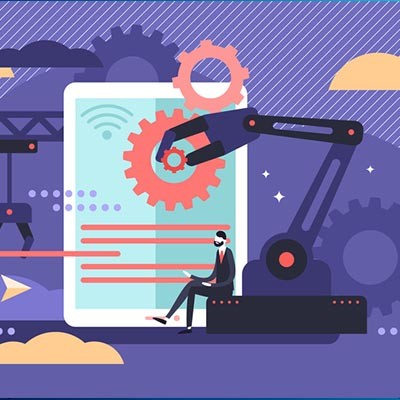In business technology, automation reigns supreme, especially for tedious tasks that offer little to the individual performing them. Remote management epitomizes such tasks, and strategic automation can greatly enhance organizational productivity. Let’s examine how automation can help you stay proactive.
Argentum IT LLC Blog
One way businesses attempt to save money is through automating certain processes and tasks that have traditionally been time-consuming or monotonous for their workforce. When implemented appropriately, automation can cut costs, streamline operations, and improve quality of life for workers. However, just because a task can be automated doesn’t necessarily mean that it should be automated. Let’s look at the arguments for and against automation in these contexts.
Businesses that sell goods have always used inventory management, whether using pen and paper or a spreadsheet. In the information age, inventory management is more complex and with a lot of businesses operating on the Internet, it is more important to manage well. This month, we will discuss what modern inventory management entails and how technology can provide the efficiency your business needs to be successful.
The Internet of Things can be a tricky concept to wrap your head around, and it certainly doesn’t help that so many new smart devices are being added to it day-in and day-out. Let’s take a look at what makes up the Internet of Things and why it’s important to know what it is from a business perspective.
One of the primary ways that modern companies work to boost efficiency is to ease the workloads that their employees have to contend with through automation. Automating certain processes frees up the time these processes would otherwise take to devote to revenue generation. This approach has worked for decades—and today, businesses have access to more automation-focused technology than ever.
Technology can have a very real impact on your company’s ability to churn out a quality product, but it can also get in the way of doing so. The difference between the two is understanding what technology you need to ensure that your business is churning out quality goods and services. This month, we thought we would take a look at quality control automation strategies for three separate parts of a business
Human resources are a part of almost any business. That is because there are a lot of Is to dot and Ts to cross in any business. Some HR departments are better than others, but typically the HR department deals with most of the elements of the business that deal with, you guessed it, the human resources (employees). Today, the HR landscape is changing as businesses are now looking to automation to handle much of the heavy lifting.
All businesses demand a certain amount of technology in order to push their organizational profitability forward. Whether they invest in tried-and-true technologies or they use their capital a little more innovatively, really depends on how decision makers’ forecasts of those investments help the organization become more productive or efficient. Today, we will look at five of the most important technology trends for SMBs in 2020.
Automation is sometimes misconceived as a troublesome or unreliable addition to business. It’s not about replacing people with machines, it’s about getting more done with the people you have. Having an attitude that doubts technology and believes nothing can replace human processing can quickly put you at a disadvantage compared to your competitors.
Automation does nothing but help businesses, but can the same be said for the people that work at these businesses? With more systems relying on some semblance of artificial intelligence, smart automation could replace up to a quarter of the current workforce over the next ten years. Today, we will take a look at the importance of profitability and how AI is likely going to usher in a whole new era of human existence.
Some parts of running your business’ infrastructure involve a lot of time… time that you simply don’t have in the day. Applying patches, monitoring network traffic, and updating software solutions are all the usual culprits. In light of this, we recommend that businesses implement a solution that allows for management to occur remotely, as it can provide a great benefit for businesses with both limited workforces and budgets.
There are some cases where productivity is a challenge, especially in the case where you’re being asked to work on something repetitive or monotonous. To make these tasks more bearable, automation solutions can be used. Although, depending on the purpose, they can become an integral part of your business’ productivity strategy.
How much time does your business spend every day on issuing patches and security updates? How about basic maintenance and management practices that leave your network technicians tied up for hours on end? Thanks to automation, these menial tasks that take a considerable amount of time and resources can be simplified and offer a great return on investment.
How much value does your company get from its technological assets? This might seem like a simple question, but it doesn’t have a simple answer. You can implement the latest and greatest solutions, but you don’t necessarily gain value from them, or as much as similar organizations in your field. With businesses aiming to cut costs and secure a profitable future, how can you make sure that IT is providing value to your organization?
Are you ready to share the road with self-driving cars? According to a recent survey by the University of Michigan, 37.2 percent of drivers are “very concerned” about riding in a self-driving car, while 66.6 percent are “very or moderately concerned.” Simply put, the public isn’t quite ready for self-driving cars. Although, the gradual adoption of vehicles equipped with assisted-driving technology is already happening.
 Companies are always looking to improve their operations by eliminating unnecessary costs. It’s a part of business, no matter how you look at it. However, as automation technologies grow more advanced, some of the more mundane (and even some professional) positions are at risk of getting replaced by cheaper, more efficient robotic systems.
Companies are always looking to improve their operations by eliminating unnecessary costs. It’s a part of business, no matter how you look at it. However, as automation technologies grow more advanced, some of the more mundane (and even some professional) positions are at risk of getting replaced by cheaper, more efficient robotic systems.
 The world might not see legitimate artificial intelligence for quite some time, but that doesn’t mean developers aren’t taking baby steps in the right direction. A current example of this is Google and its automated vehicles. If Google is capable of successfully making a self-driving car that’s aware of its surroundings, we might see them on the roads as early as 2020.
The world might not see legitimate artificial intelligence for quite some time, but that doesn’t mean developers aren’t taking baby steps in the right direction. A current example of this is Google and its automated vehicles. If Google is capable of successfully making a self-driving car that’s aware of its surroundings, we might see them on the roads as early as 2020.
 How often does autocorrect breathe down your neck when you type out emails or documentation? We might have it now, but before autocorrect was introduced, every little mistake had to be resolved manually, without the help of technology. So, we salute you, autocorrect; saving us from the grammar police since the early 90s.
How often does autocorrect breathe down your neck when you type out emails or documentation? We might have it now, but before autocorrect was introduced, every little mistake had to be resolved manually, without the help of technology. So, we salute you, autocorrect; saving us from the grammar police since the early 90s.
 As technology grows more advanced, humans turn to robots to replace certain monotonous jobs. The goal here is to create a society where people are free to spend more time enjoying life. However, technology is prone to both technical problems and user error, which can lead to disastrous consequences.
As technology grows more advanced, humans turn to robots to replace certain monotonous jobs. The goal here is to create a society where people are free to spend more time enjoying life. However, technology is prone to both technical problems and user error, which can lead to disastrous consequences.















